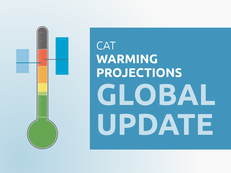Publications (Brazil)
Some progress since Paris, but not enough, as governments amble towards 3°C of warming
The Climate Action Tracker (CAT) estimate of the total warming of the aggregate effect of Paris Agreement commitments and of real-world policy shows little change. If all governments achieved their Paris Agreement commitments the world will likely warm 3.0°C—twice the 1.5°C limit they agreed in Paris. Underneath the lack of read more...
Paris Tango. Climate action so far in 2018: individual countries step forward, others backward, risking stranded coal assets
The Climate Action Tracker has updated our assessments of 23 of the 32 countries whose development on climate action we track.While some progress has been made since November, most governments’ policies are still not on track towards meeting their Paris Agreement commitments, many of which are in themselves far from read more...
Improvement in warming outlook as India and China move ahead, but Paris Agreement gap still looms large
The Climate Action Tracker has updated its estimates of global progress towards the Paris Agreement goals, with some positive and negative findings: Significant improvement on climate action globally, despite US rollbacks0.2°C improvement in climate action since 2016, reducing projected warming by 2100 to 3.4°C. For the first time since the read more...
Climate pledges will bring 2.7°C of warming, potential for more action
With 158 climate pledges now submitted to the UN, accounting for 94% of global emissions, the Climate Action Tracker today confirmed this would result in around 2.7°C of warming in 2100 – if all governments met their pledge. “This level of warming is still well above the agreed limit of read more...
G20 - all INDCs in, but large Gap remains
The 2015 G20 Summit, (Turkey, 15-16 November) will see Heads of State and Government meet to discuss, among other issues, development, energy and climate change finance.All G20 members have presented their “intended nationally determined contributions” or INDCs, to the UNFCCC for the Paris Agreement. The Climate Action Tracker (CAT) has read more...
Will an in increase in share of renewable power in Brazil and United States be enough to curb emissions to levels consistent with necessary reductions in the countries?
The 20% goal for renewables in the US and Brazilian power sectors is a step in the rightdirection. The main positive point is that it is an example of countries agreeing to worktogether on their way to low carbon economy. In both, Brazil and the United States long-termpolicies ensuring investment read more...
Analysis of current greenhouse gas emission trends
Policy activity has to increase significantly in order to limit global average temperature increase to 2°C above the pre-industrial level. With currently implemented government policies, greenhouse gas emissions are projected to lead to a warming of 3.7°C by the end of this century, about 0.6°C higher than that under the read more...
2° be or not 2° be
Limiting global warming below 2degC – or even to below 1.5DegC remains technically and economically feasible, but only with political ambition backed by rapid action starting now, the Climate Action Tracker said today.
Reality gap: Some countries progress in national polices, but many risk failing to meet pledges
In this update, the Climate Action Tracker provides insights for Brazil, the USA, Mexico, Japan and South Korea on actions on climate change, new economic and energy data, government policies and announcements and developments at the UN climate talks.
Negotiations heading towards high warming, high cost pathway
Delaying any decisions on future climate action until 2015 or 2020 will bring a rapidly increasing risk in costs and threatens the likelihood of the world being able to keep global warming to below 2 degrees C, the Climate Action Tracker warned today in its Durban update.We are heading toward read more...
Stay informed
Subscribe to our newsletter

